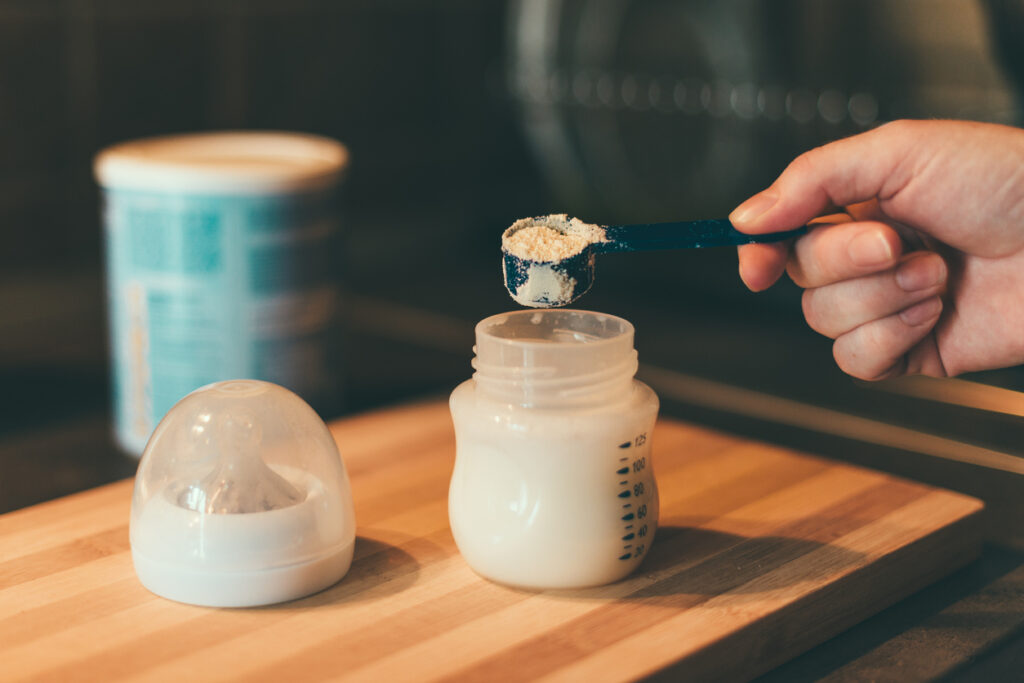Mother’s milk has always been and remains the ideal food for your baby. How can it not be? It’s 100% natural food made by nature itself. However, there might be a number of reasons why it’s recommended to switch to formula feeding. In such cases, it’s important to choose the right product for your baby in order to ensure that he/she gets adequate nutrition.
How to choose the perfect infant formula for your child

There are many types of baby foods and the most important thing in choosing one is to understand what kind of nutritional objective it fulfills. The history of milk formulas goes back more than 150 years.
Research and development helped create products that are as close to mother’s milk as possible. These foods are made according to the age-specific digestive and metabolic needs of babies in their first year of life.
Every parent strives to give their baby only the best, but when it comes to choosing the type of formula, it’s important to understand that there is no ideal option. It’s often not easy for parents to choose the right infant milk. Let’s try to figure out the variety offered today by the baby formula market.
At a larger scale, all infant formulas available today are divided into 3 main groups:
- Products for healthy babies
- Specialized milk for infants with special nutritional needs
- Therapeutic formulae for babies with any kind of pathology
In their turn, these products are divided into two main groups: first milks and follow-on milks. They differ in accordance with the age they are intended for. The thing is the composition of human milk changes as your baby grows.
Their digestive system also matures and their body’s need for nutrients changes. In order to find the right formula for your baby’s age and needs, the formula number is indicated on the package of the formula:
“0”/”Pre”: for premature or low-birth-weight babies
“1”: for babies from 0 to 6 months
“2”: for babies from 6 months to 1 year
“3”: for babies over 12 months.
Infant formula also differs based on:
- consistency (dry or liquid)
- composition (casein-based or whey-based)
So what’s the best food to give your baby?
The one that will allow your little one to develop at a normal speed physically and mentally. Before taking your pick, ask your pediatrician: they’ll always give competent advice. In other words, the best infant formula to give your child is the one that’s right for their age and meets all their nutritional needs.
How to feed infant formula to your baby?

As a rule, there’s a certain routine to follow: daytime feedings at set time intervals and nighttime feedings upon awakening. Normally, it’s about 8 times during the daytime (approximately every 3 hours). However, you should always take your child’s individual needs into account.
How much formula should your child eat?
When thinking about how to transition from breastmilk to formula, new mothers might sometimes have a hard time calculating the amount of food they should give their children. For babies up to 10 days old, multiply the number of days of their life by 10. There’s another method – by weight. If an infant weighs less than 3,200 grams, the number of days of their life is multiplied by 70, if more – by 80.
At up to 1.5 months, your baby should eat a portion of ⅕ of his/her weight (600-900 ml). At up to 4 months – ⅙ of their body weight (800 to 1000 ml). At up to six months – 1/7 and up to a year – 1/8 of their body weight. There’s s no need to panic if these figures are a little different from the actual situation. Just watch your baby and how they react to the amount of food you give them.
How to know infant milk isn’t good for your child?

Redness or flaking of the skin, allergic rashes, digestive disorders, minimal or no weight gain or weight loss, restless sleep, lethargy, or increased excitability are things that you need to pay attention to. If after 2-3 days there’s no improvement, consult your pediatrician. If these symptoms last less than that, it just means their body was adapting to the new type of food.
Why Opting for Organic Infant Formula Might be a Good Choice
In recent years, the baby formula market has witnessed an increase in organic products. Parents who are environmentally conscious or wary of chemical processes and additives often gravitate towards organic formulas.
Organic infant formulas are made from milk sourced from cows that are raised without synthetic hormones, pesticides, or genetically modified organisms (GMOs). This means that the base ingredients in these formulas are free from harmful chemicals that might be present in conventional formulas.
Moreover, Holle Bio Formulas often abstain from using artificial sweeteners, colors, or preservatives. This can be crucial because, in their early months, babies have a developing digestive system, making them more susceptible to the potential adverse effects of these additives.
It’s worth noting that the organic label also extends to farming practices. This ensures that the animals are raised in humane conditions, fed with organic feed, and the farms adopt sustainable agricultural practices, which is better for our planet.
However, like with any product, it’s essential to read the label and ensure that the formula meets all the required nutritional standards. Some organic formulas might still have added sugars or other ingredients that are not ideal. Always do thorough research and, when in doubt, consult your pediatrician.
They can provide recommendations tailored to your child’s specific needs, ensuring they receive the best nutrition possible. Whether you opt for organic or conventional, the well-being of your child is paramount.
How long should formula feed last?
Experts’ opinions vary – some think it should be done at least until the age of 2, others – until the age of 3. Still, others argue that the deadline is 1 year because babies start getting complementary feeding as soon as at 6 months of age, and the need for night feeding slopes to zero. It’s up to the parents to decide, with some assistance from a pediatrician.
How to choose the right baby food?

Examine the packaging carefully. It must contain the following information:
- A complete list of ingredients
- Nutritional and caloric information
- What age it’s appropriate for
- Storage conditions
- Expiry date
- Method of preparation and the required amount of product per serving
The taste and smell should be natural and strictly consistent with the composition. Experts recommend sticking to the products of the same brand.
Baby formula feeding tips
Many infant foods are based on cow’s milk, which might be difficult to digest. Extensively hydrolyzed products might be a better option. Or you might opt for products based on goat’s milk: their protein composition is closer to breast milk and easier to digest.
For newborns, ingredients like added sugars are highly undesirable. They can cause colic and cramps. And added salt stresses the kidneys. Gluten is hard to digest and can lead to allergic reactions. At first, opt for hypoallergenic products and gradually introduce products with gluten.
Young parents are advised not to make any changes to their baby’s diet on their own. Every mother, in order to avoid unpleasant consequences, must get prior medical advice and only then buy the formula. A trained pediatrician will explain in detail how to do formula feeding right.







